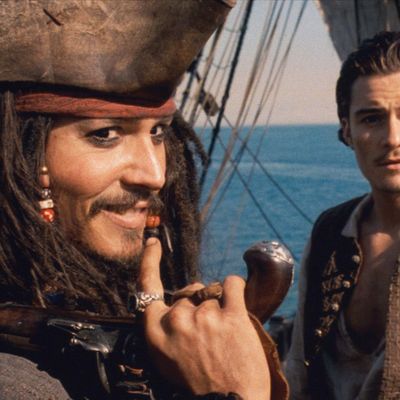
In the 14 years since the first movie’s release, it’s become easy to take the Pirates of the Caribbean franchise for granted. The fourth entry in the series, On Stranger Tides, was critically thrashed and has been largely forgotten. According to Vulture’s David Edelstein, the newest installment, Dead Men Tell No Tales, isn’t much better. But to dismiss Pirates as a whole is to ignore the alchemy that director Gore Verbinski pulled off with his original trilogy, The Curse of the Black Pearl, Dead Man’s Chest, and At World’s End.
The Pirates franchise should not work. It’s based on a theme-park ride with no discernible plot or characters, and pirates have been a non-presence at the multiplex for the past several decades. For family-friendly properties, the movies are incredibly dark. (The Curse of the Black Pearl marked Disney’s first PG-13 rating.) They’re also inimitably strange; the series’ most iconic sequences all lean into the bizarre, from the sight of human bodies shifting into skeletons and back again, to an entire ship turning upside down as its crew returns from the land of the dead.
Relatively speaking, The Curse of the Black Pearl is the tamest installment of the three, but even it is one of the stranger blockbusters of the last decade. As Captain Barbossa, Geoffrey Rush is particularly good at navigating the tonal shifts between the breezy adventure and the darker material that sets it apart from the rest of the summer crop. Rush plays Barbossa with an archness that only makes things more unsettling when the wink disappears. It’s easy to tell that something’s off as he watches a captive Elizabeth Swann (Keira Knightley) eat — as the smile on his face changes into an expression of longing and mania, the movie transitions into its first full-on fright sequence at almost a full hour in, as the crew reveal their true skeletal forms in the moonlight.
It’s horrifying, yes, but it has less to do with the undead than the idea of the pirates’ unending purgatory. Similarly, when the Kraken finally shows up halfway through Dead Man’s Chest, it invokes terror not just because of its monstrous stature but because the scene has emotional stakes. Will Turner (Orlando Bloom in the Errol Flynn role) has only just discovered that his father (Stellan Skarsgard) is still alive. However, Dad’s serving out 100 of servitude aboard the Flying Dutchman. To make matters worse, the crew of the Dutchman become less human the longer they stay upon the ship; as Will’s father watches the Kraken devour the ship his son is supposedly on, a new barnacle forms upon his face. There’s further exploration into grief in Elizabeth’s story, too: She only discovers the death of her father (Jonathan Pryce) when she sees him floating by in a little boat with all the other dead souls in Davy Jones’s Locker. It’s a strikingly bleak scene. He refuses her pleading to come back with her to the land of the living, telling her instead that he’s proud of her as he floats out of reach.
But the franchise’s strangeness isn’t limited to darkness. The best comic beats in the Pirates movies come with an odd twist to them, too. Consider the bone cages in Dead Man’s Chest, which start as jail cells, turn into tetherballs, and then, by sequence’s end, become gigantic hamster wheels.
At World’s End sets up an even more ludicrous sequence, as Will and Elizabeth are married during the final fight, both of them now finally real pirates, with Will soon to be captain of the Flying Dutchman and Elizabeth having been crowned the Pirate King. A harried Barbossa performs the ceremony while tangling swords with the Dutchman’s crew, as the Pearl and the Dutchman are both pulled into a giant whirlpool. It’s funny, but just as earnest as the rest of the trilogy. Romance plays as big a part in Pirates as piracy — actual hearts get cut out for the sake of love.
Romance aside, the series’ character dynamics do Fast and Furious before Fast and Furious did, as ancillary characters return and villains become good guys as necessary. One of the greatest pleasures of Dead Man’s Chest is the very ending, as Barbossa returns from the dead, strides into frame, and chomps down on an apple. At World’s End sees the Marines Murtogg and Mullroy (Giles New and Angus Barnett) desert the East India Trading Company to join the Black Pearl’s crew. Their pirate counterparts, Pintel and Ragetti (Lee Arenberg and Mackenzie Crook), see their roles beefed up, too, going from comic relief to essential members of the Pearl’s crew. Once regulars, they’re treated with a certain tenderness; At World’s End even gives Ragetti a hint of a romance plot, making him the one to free the sea goddess Calypso (Naomie Harris) with an incantation that must be spoken “as if to a lover.”
Horror, romance, and comedy — the trilogy mixes and twists them to create something unique. This blend works because the series doesn’t treat these elements as mutually exclusive; there are funny and wondrous things about the unknown, just as much as there is fear, and that sense of wonder is imbued in the action scenes, the characters, and the music. (Klaus Badelt and Hans Zimmer’s score has one of the last theme tunes to become ubiquitous.) The last two movies may be the franchise coasting, but it’s easy to coast when you’re coming down from such dizzying heights.

